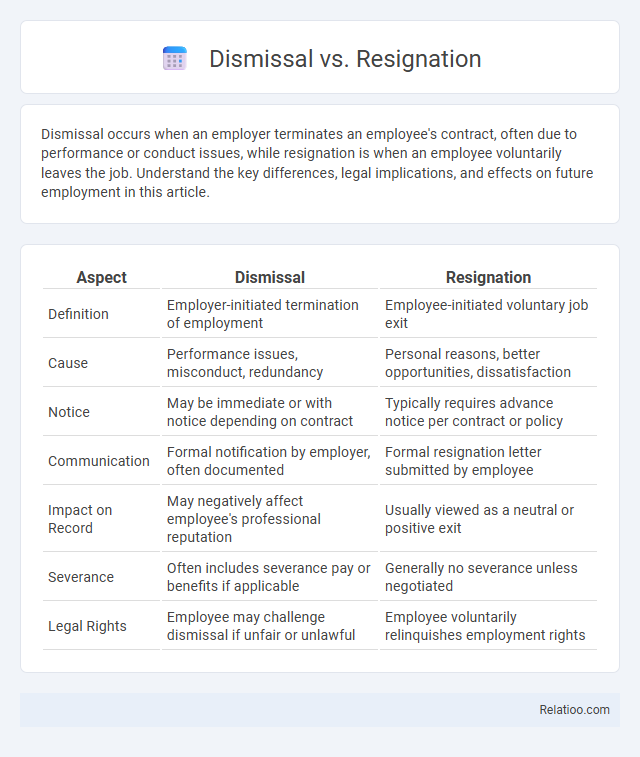Dismissal occurs when an employer terminates an employee's contract, often due to performance or conduct issues, while resignation is when an employee voluntarily leaves the job. Understand the key differences, legal implications, and effects on future employment in this article.
Table of Comparison
| Aspect | Dismissal | Resignation |
|---|---|---|
| Definition | Employer-initiated termination of employment | Employee-initiated voluntary job exit |
| Cause | Performance issues, misconduct, redundancy | Personal reasons, better opportunities, dissatisfaction |
| Notice | May be immediate or with notice depending on contract | Typically requires advance notice per contract or policy |
| Communication | Formal notification by employer, often documented | Formal resignation letter submitted by employee |
| Impact on Record | May negatively affect employee's professional reputation | Usually viewed as a neutral or positive exit |
| Severance | Often includes severance pay or benefits if applicable | Generally no severance unless negotiated |
| Legal Rights | Employee may challenge dismissal if unfair or unlawful | Employee voluntarily relinquishes employment rights |
Understanding Dismissal and Resignation
Dismissal refers to an employer-initiated termination of employment due to reasons such as poor performance, misconduct, or redundancy, often involving formal procedures and documentation. Resignation is a voluntary act by an employee to end their employment, typically requiring notice as specified in the contract or labor laws. Understanding the distinctions between dismissal and resignation is crucial for compliance with labor regulations and for ensuring proper rights and obligations regarding final pay, benefits, and unemployment claims.
Key Differences Between Dismissal and Resignation
Dismissal occurs when an employer terminates your employment due to performance issues, misconduct, or organizational changes, often involving formal procedures and possible legal rights. Resignation is your voluntary decision to leave a job, typically requiring notice as specified in your contract, reflecting a personal choice rather than employer action. The key difference lies in control and consequences: dismissal may affect future employment references and benefits, while resignation generally preserves a more positive professional reputation.
Legal Implications of Dismissal
Legal implications of dismissal often involve strict compliance with labor laws, ensuring just cause such as misconduct or redundancy to avoid wrongful termination claims. Unlike resignation, which is initiated by the employee, dismissal requires employers to follow due process, including proper documentation and notice periods, to prevent disputes. Understanding these legal distinctions protects your rights and helps employers mitigate risks related to employment termination.
Legal Implications of Resignation
Resignation typically involves an employee voluntarily ending their job, which means you may forfeit certain legal protections such as wrongful termination claims. Unlike dismissal, which is initiated by the employer and often requires adherence to specific legal procedures, resignation generally requires providing notice as stipulated in your contract or labor laws. Understanding these distinctions ensures you protect your rights and fulfill your legal obligations when leaving a position.
Common Reasons for Employee Dismissal
Common reasons for employee dismissal include poor performance, violation of company policies, absenteeism, and misconduct such as theft or harassment. Employers often dismiss employees when they fail to meet job expectations despite feedback and improvement plans. Your understanding of these reasons can help differentiate dismissal from resignation, where the employee voluntarily leaves, and termination, which may also encompass layoffs due to business needs.
Typical Causes for Employee Resignation
Typical causes for employee resignation include lack of career growth, poor management, and inadequate compensation. You may choose to resign when your work environment fails to meet your professional or personal needs, prompting a proactive decision to seek better opportunities. Understanding these factors helps employers address retention challenges and improve workplace satisfaction.
Rights and Obligations of Employers
Employers must navigate distinct obligations when managing dismissal, resignation, and termination processes, ensuring compliance with labor laws that protect employee rights. In dismissals, employers are required to provide valid reasons, adhere to procedural fairness, and offer severance or notice periods as mandated by jurisdictional regulations. Resignations typically impose fewer obligations on employers, but they must still process final pay, benefits, and ensure clear documentation to avoid disputes.
Employee Rights in Dismissal and Resignation
Employee rights in dismissal typically include the right to receive a fair hearing, written notice, and severance pay depending on jurisdiction and employment contracts. During resignation, employees retain the right to receive final wages, accrued benefits, and may request a reference or confirmation letter from the employer. Legal protections against unfair dismissal ensure employees can challenge termination decisions that violate labor laws or contractual agreements.
Impact on References and Future Employment
Dismissal often results in negative references, potentially hindering future job prospects due to questions about performance or behavior. Resignation usually allows for more positive or neutral references, as it implies a voluntary departure often framed better by employers. Termination by mutual agreement can vary widely in its impact on references, depending on the circumstances and agreement terms, sometimes creating less stigma than outright dismissal.
Best Practices for a Smooth Employment Separation
Understanding the distinctions between dismissal, resignation, and termination is crucial for managing employment separation smoothly and professionally. Implement clear documentation, maintain open communication, and ensure legal compliance to protect both parties during the separation process. Following these best practices helps safeguard Your rights while minimizing potential disputes and fostering respect in the transition.

Infographic: Dismissal vs Resignation
 relatioo.com
relatioo.com